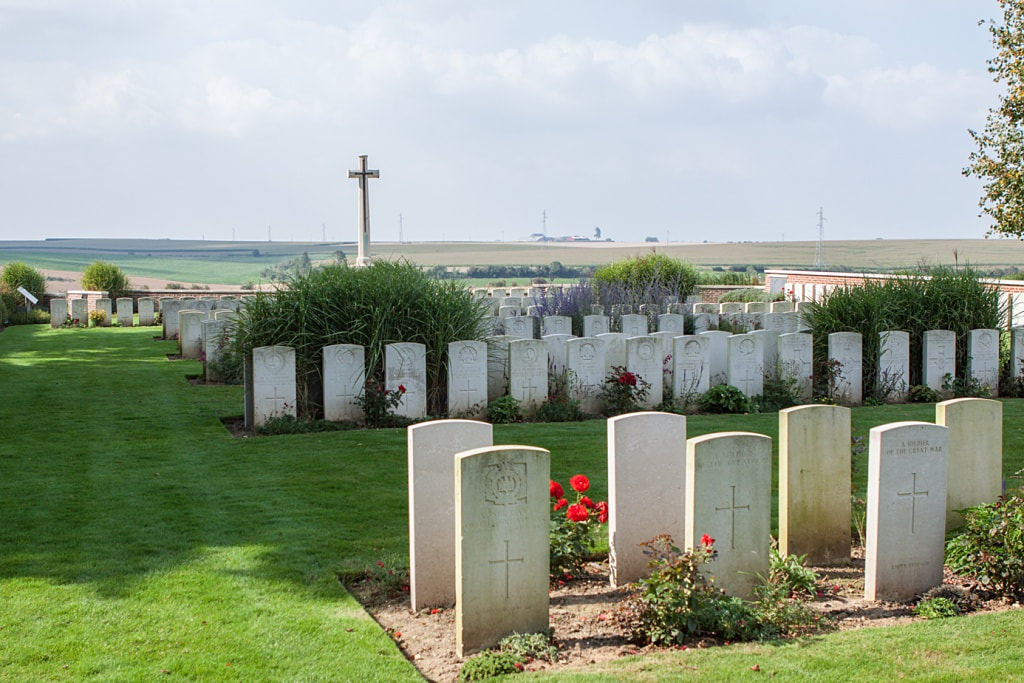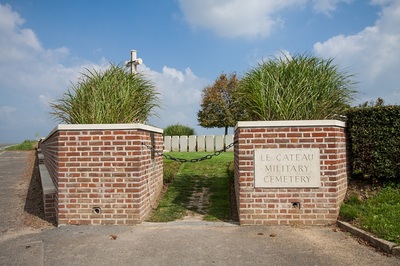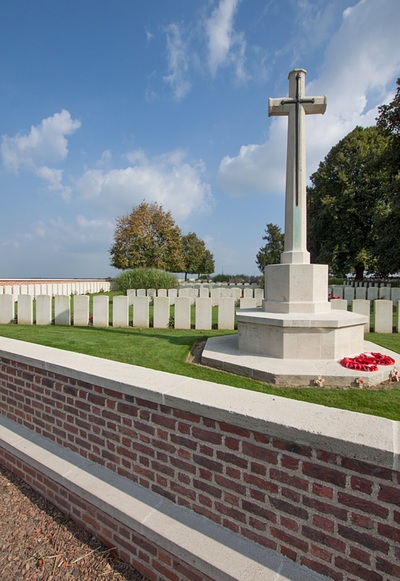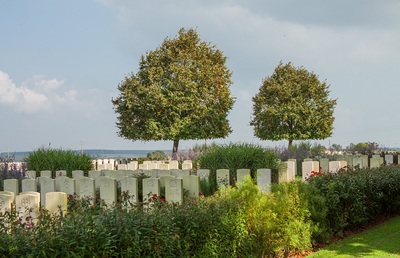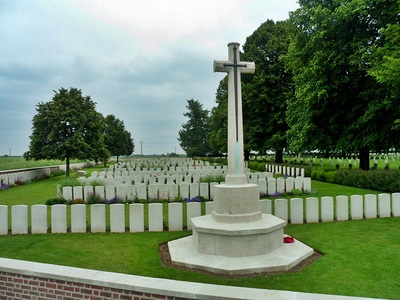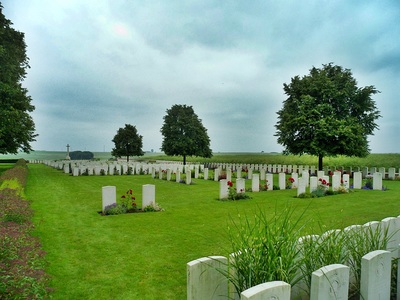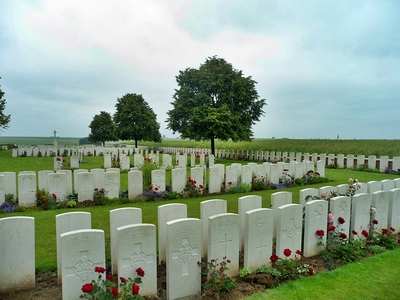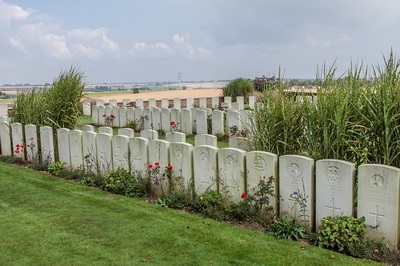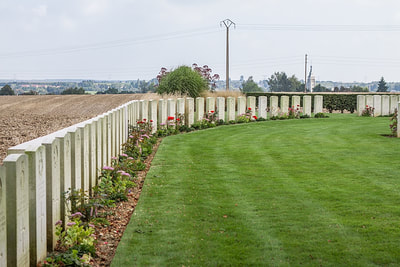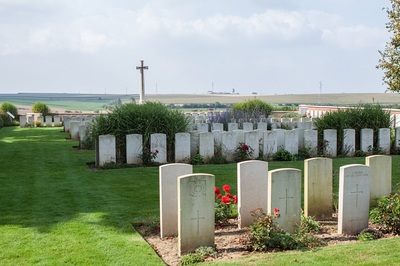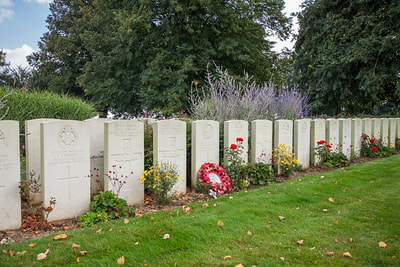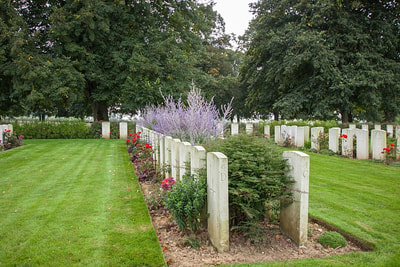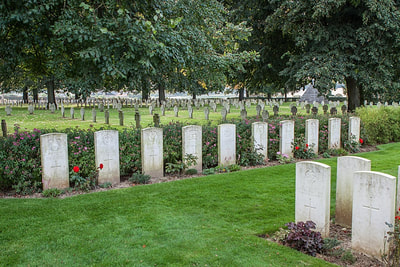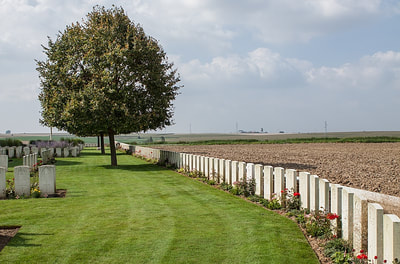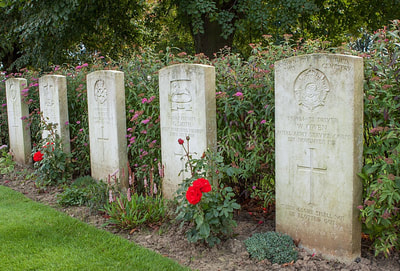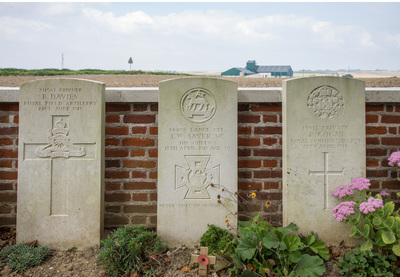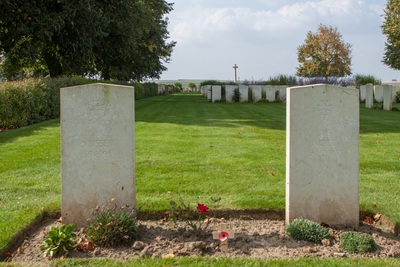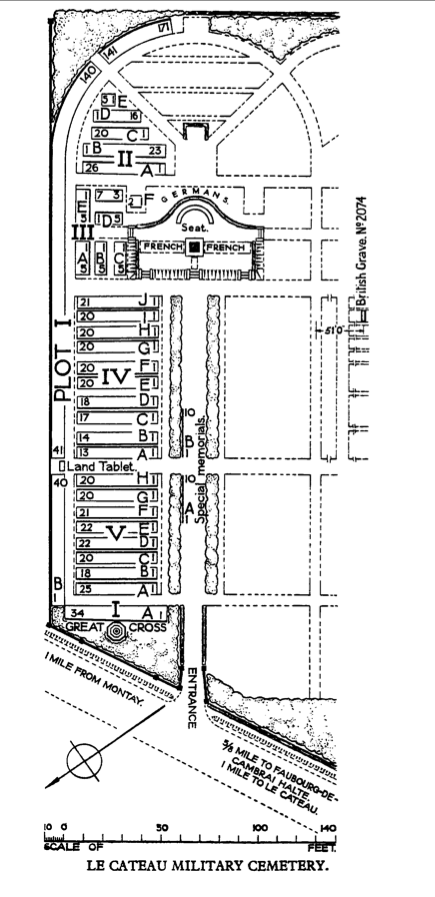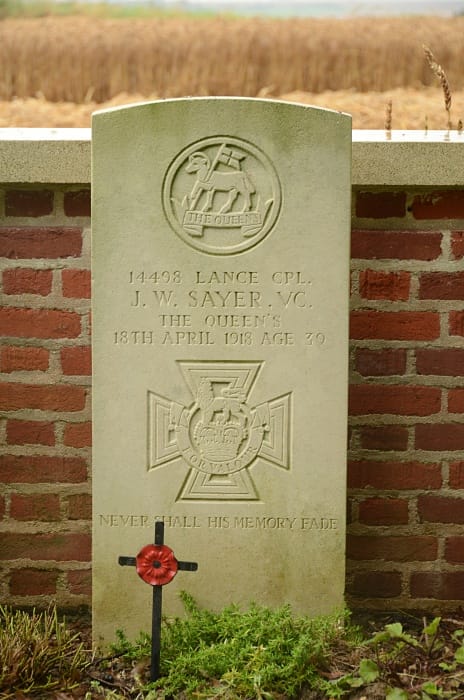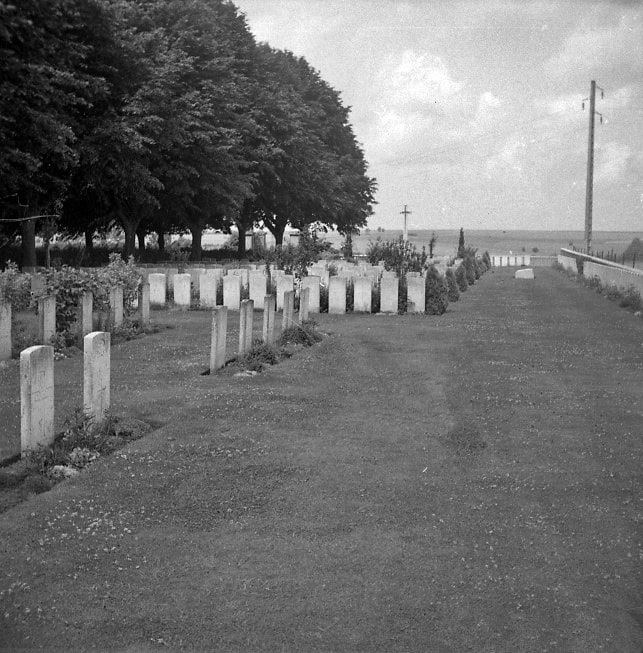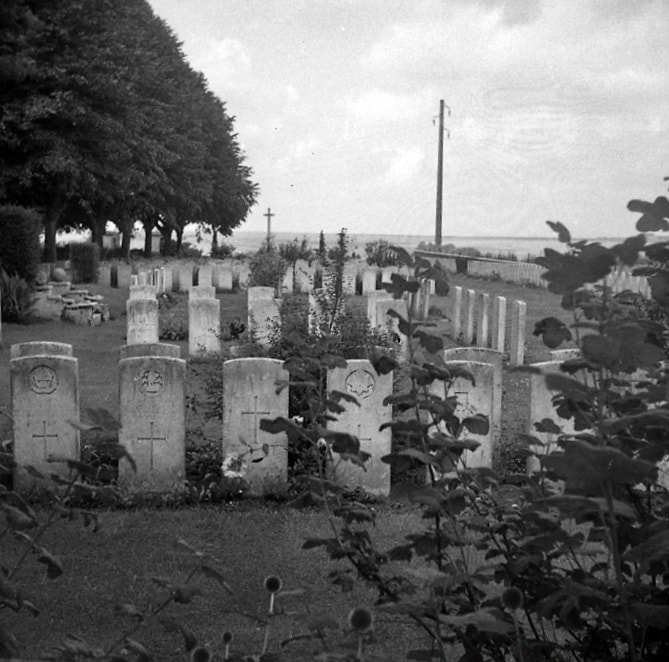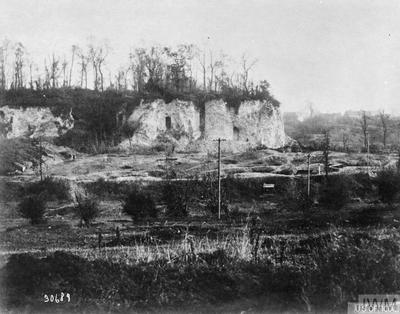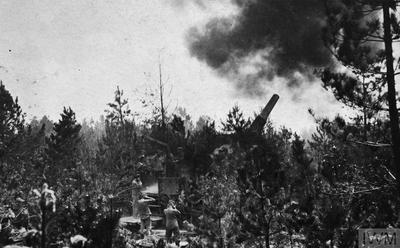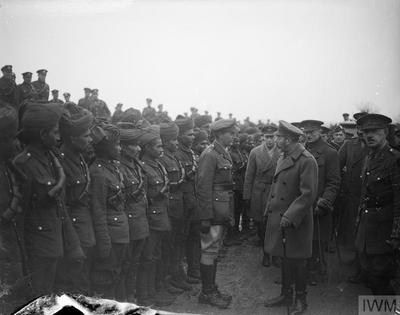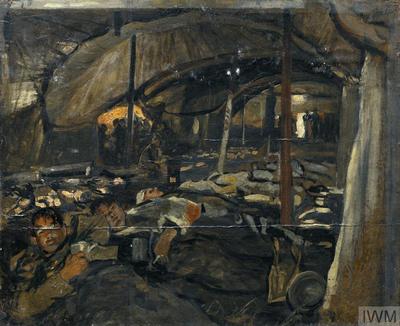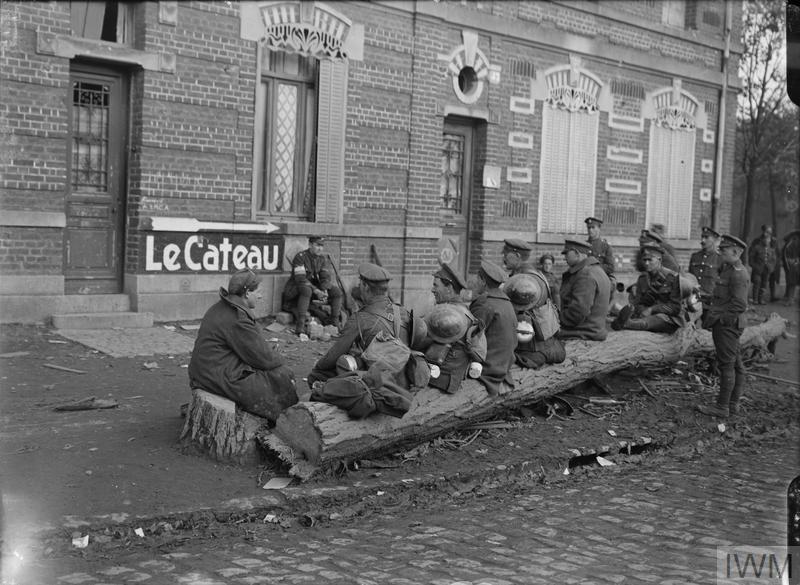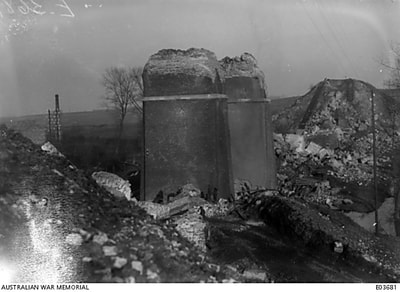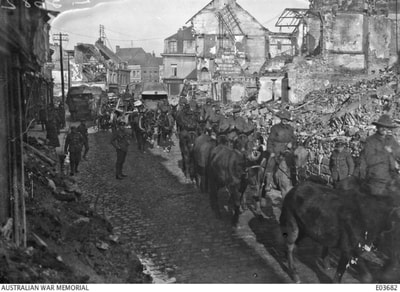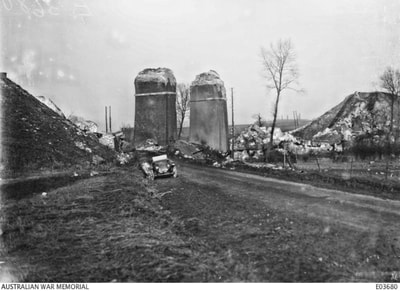LE CATEAU MILITARY CEMETERY
Nord
France
GPS Coordinates - Latitude: 50.11045, Longitude: 3.52701
Location Information
Le Cateau is a small town approximately 27 kilometres east-south-east of Cambrai. From Cambrai, take the N43 to its junction with D932, approximately 22.5 kilometres from Cambrai centre. Turn left at the junction and the cemetery lies on the right side, 400 metres along this road.
Visiting Information
Wheelchair access to this cemetery is possible with some difficulty.
Historical Information
Le Cateau Military Cemetery
Le Cateau-Cambrésis and the country to the west of it was the scene of a battle fought by the British II Corps on 26 August 1914 against a greatly superior German force. The town remained in German hands from that date until the evening of 10 October 1918, when it was rushed by the 5th Connaught Rangers and finally cleared a week later. During the war Le Cateau had been a German railhead and the site of an important hospital centre. The military cemetery was laid out by the Germans in February 1916 with separate plots for the Commonwealth and German dead. It contains the graves of over 5,000 German soldiers, many of whom were buried during the occupation, the rest being brought in from other German cemeteries after the Armistice. A separate plot contains the graves of 34 Russian prisoners of war who died in captivity. The Commonwealth plot is the site of almost 700 graves and commemorations of the First World War.
The Battle of Le Cateau
The first major battle between the British Expeditionary Force (BEF) and the German Imperial Army on the Western Front took place at Mons on 23 August 1914. By 25 August, the German First Army was close on the heels of the II Corps of the BEF, and there was a danger that the retreating British troops, now exhausted and in some disarray, would be overrun and defeated if the withdrawal continued. By nightfall, General Smith-Dorrien had decided that II Corps, along with a detachment of French Cavalry under General Sordet, would stand and face the advancing German forces the following day at Le Cateau. Shortly after dawn broke on 26 August, German artillery batteries located about three miles to the north-east began firing on British troops who were still taking up their positions to the west of the town. As the first shells landed, German cavalry appeared from the direction of Cambrai and began advancing toward the British lines of defence. Almost simultaneously, German infantry units launched a surprise attack on the men of the East Surrey and Duke of Cornwall regiments who had stationed themselves in the eastern outskirts of the town.
For the next six hours, French and British troops laid down withering rifle and artillery fire and, despite suffering heavy casualties, managed to hold a greatly superior German force at bay. By midday, more German units were entering the battlefield, enemy artillery fire was becoming more intense, and it was clear that the Allied forces, numbering about 40,000 men, would have to begin to retreat or prepare to surrender. Soon after 1.00 p.m., British artillery units, some of which had been stationed alongside the infantry in the front-line, began to slowly withdraw from the battlefield. Fierce fighting continued for the rest of the day, and several British units were almost completely wiped out, but by sunset most Allied soldiers had successfully withdrawn.
In total, over 7,000 British and French soldiers were killed, wounded, or taken prisoner and 38 British artillery pieces were captured at Le Cateau, while the German forces suffered approximately 5,000 casualties. The battle had been a costly one, but the stand taken by II Corps temporarily stemmed the German advance and bought the Allied forces in the northern sector valuable time as they retreated towards the Marne.
Casualty Details: UK 659, Canada 3, Australia 3, New Zealand 2, South Africa 28, Germany 2, Total Burials: 700
The cemetery was designed by Charles Henry Holden & William Harrison Cowlishaw
Le Cateau is a small town approximately 27 kilometres east-south-east of Cambrai. From Cambrai, take the N43 to its junction with D932, approximately 22.5 kilometres from Cambrai centre. Turn left at the junction and the cemetery lies on the right side, 400 metres along this road.
Visiting Information
Wheelchair access to this cemetery is possible with some difficulty.
Historical Information
Le Cateau Military Cemetery
Le Cateau-Cambrésis and the country to the west of it was the scene of a battle fought by the British II Corps on 26 August 1914 against a greatly superior German force. The town remained in German hands from that date until the evening of 10 October 1918, when it was rushed by the 5th Connaught Rangers and finally cleared a week later. During the war Le Cateau had been a German railhead and the site of an important hospital centre. The military cemetery was laid out by the Germans in February 1916 with separate plots for the Commonwealth and German dead. It contains the graves of over 5,000 German soldiers, many of whom were buried during the occupation, the rest being brought in from other German cemeteries after the Armistice. A separate plot contains the graves of 34 Russian prisoners of war who died in captivity. The Commonwealth plot is the site of almost 700 graves and commemorations of the First World War.
The Battle of Le Cateau
The first major battle between the British Expeditionary Force (BEF) and the German Imperial Army on the Western Front took place at Mons on 23 August 1914. By 25 August, the German First Army was close on the heels of the II Corps of the BEF, and there was a danger that the retreating British troops, now exhausted and in some disarray, would be overrun and defeated if the withdrawal continued. By nightfall, General Smith-Dorrien had decided that II Corps, along with a detachment of French Cavalry under General Sordet, would stand and face the advancing German forces the following day at Le Cateau. Shortly after dawn broke on 26 August, German artillery batteries located about three miles to the north-east began firing on British troops who were still taking up their positions to the west of the town. As the first shells landed, German cavalry appeared from the direction of Cambrai and began advancing toward the British lines of defence. Almost simultaneously, German infantry units launched a surprise attack on the men of the East Surrey and Duke of Cornwall regiments who had stationed themselves in the eastern outskirts of the town.
For the next six hours, French and British troops laid down withering rifle and artillery fire and, despite suffering heavy casualties, managed to hold a greatly superior German force at bay. By midday, more German units were entering the battlefield, enemy artillery fire was becoming more intense, and it was clear that the Allied forces, numbering about 40,000 men, would have to begin to retreat or prepare to surrender. Soon after 1.00 p.m., British artillery units, some of which had been stationed alongside the infantry in the front-line, began to slowly withdraw from the battlefield. Fierce fighting continued for the rest of the day, and several British units were almost completely wiped out, but by sunset most Allied soldiers had successfully withdrawn.
In total, over 7,000 British and French soldiers were killed, wounded, or taken prisoner and 38 British artillery pieces were captured at Le Cateau, while the German forces suffered approximately 5,000 casualties. The battle had been a costly one, but the stand taken by II Corps temporarily stemmed the German advance and bought the Allied forces in the northern sector valuable time as they retreated towards the Marne.
Casualty Details: UK 659, Canada 3, Australia 3, New Zealand 2, South Africa 28, Germany 2, Total Burials: 700
The cemetery was designed by Charles Henry Holden & William Harrison Cowlishaw
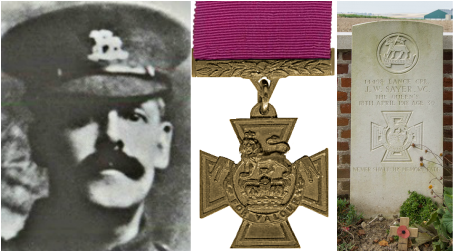
14498 Lance Corporal John William Sayer, V. C.
8th Bn. The Queen's (Royal West Surrey) Regiment, died of wounds on 18th April 1918 aged 39, Plot I. B. 59.
Son of Samuel and Margaret Sayer, of Chadwell Heath, Essex; husband of Edith Louise Sayer, of 35, Old London Rd., Hastings, Sussex.
His headstone bears the inscription; "Never Shall His Memory Fade."
Citation: An extract from the "London Gazette," dated 6th June, 1919, records the following:-"For most conspicuous bravery, determination and ability displayed on the 21st March, 1918, at Le Verguier, when holding for two hours, in face of incessant attacks, the flank of a small isolated post. Owing to mist the enemy approached the post from both sides to within 30 yards before being discovered. Lance-Corporal Sayer, however, on his own initiative and without assistance, beat off a succession of flank attacks and inflicted heavy casualties on the enemy. Though attacked by rifle and machine-gun fire, bayonet and bombs, he repulsed all attacks, killing many and wounding others. During the whole time he was continuously exposed to rifle and machine-gun fire, but he showed the utmost contempt of danger and his conduct was an inspiration to all. His skilful use of fire of all descriptions enabled the post to hold out till nearly all the garrison had been killed and himself wounded and captured. He subsequently died as a result of wounds at Le Cateau."
8th Bn. The Queen's (Royal West Surrey) Regiment, died of wounds on 18th April 1918 aged 39, Plot I. B. 59.
Son of Samuel and Margaret Sayer, of Chadwell Heath, Essex; husband of Edith Louise Sayer, of 35, Old London Rd., Hastings, Sussex.
His headstone bears the inscription; "Never Shall His Memory Fade."
Citation: An extract from the "London Gazette," dated 6th June, 1919, records the following:-"For most conspicuous bravery, determination and ability displayed on the 21st March, 1918, at Le Verguier, when holding for two hours, in face of incessant attacks, the flank of a small isolated post. Owing to mist the enemy approached the post from both sides to within 30 yards before being discovered. Lance-Corporal Sayer, however, on his own initiative and without assistance, beat off a succession of flank attacks and inflicted heavy casualties on the enemy. Though attacked by rifle and machine-gun fire, bayonet and bombs, he repulsed all attacks, killing many and wounding others. During the whole time he was continuously exposed to rifle and machine-gun fire, but he showed the utmost contempt of danger and his conduct was an inspiration to all. His skilful use of fire of all descriptions enabled the post to hold out till nearly all the garrison had been killed and himself wounded and captured. He subsequently died as a result of wounds at Le Cateau."
July 1975 - ©CWGC
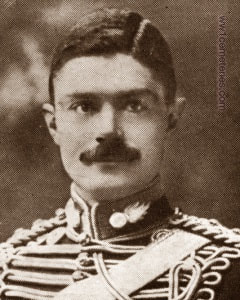
Lieutenant
James Arthur Bowles
Adjt. 28th Bde. Royal Field Artillery
26th August 1914, aged 31.
Sp. Mem. A. 10.
Son of Maj. Gen. F. A. Bowles, R.A., of Hartnolls, Tiverton Devon; husband of Dorothy Emily Bow;es, of The Warren Farm, Knockdown, Tetbury, Glos.
His headstone bears the inscription; "Their Glory Shall Not Be Blotted Out."
James Arthur Bowles
Adjt. 28th Bde. Royal Field Artillery
26th August 1914, aged 31.
Sp. Mem. A. 10.
Son of Maj. Gen. F. A. Bowles, R.A., of Hartnolls, Tiverton Devon; husband of Dorothy Emily Bow;es, of The Warren Farm, Knockdown, Tetbury, Glos.
His headstone bears the inscription; "Their Glory Shall Not Be Blotted Out."
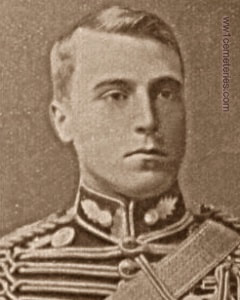
,Captain
Charles Hunter Browning
124th Bty. 28th Bde. Royal Field Artillery
26th August 1914, aged 36.
Plot III. B. 5.
Son of Capt. Hugh E. Browning, late of Clapham Park, Beds. Served in the South African Campaign.
His headstone bears the inscription; "We Will Go Forward At Whatever Cost Quietly, Untiringly, Unalarmed."
Charles Hunter Browning
124th Bty. 28th Bde. Royal Field Artillery
26th August 1914, aged 36.
Plot III. B. 5.
Son of Capt. Hugh E. Browning, late of Clapham Park, Beds. Served in the South African Campaign.
His headstone bears the inscription; "We Will Go Forward At Whatever Cost Quietly, Untiringly, Unalarmed."
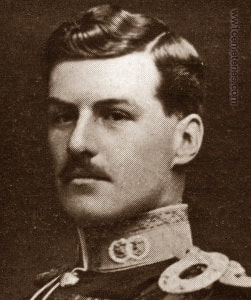
Captain
The Hon. Robert Browning
2nd Bn. Argyll and Sutherland Highlanders
26th August 1914, aged 34.
Plot III. C. 2.
(Master of Burleigh). Son of Lord and Lady Balfour of Burleigh, of Kennet, Alloa, Scotland.
His headstone bears the inscription; "Omne Solum Porti Patria." (Latin - Every land is a homeland for the courageous man.)
The Hon. Robert Browning
2nd Bn. Argyll and Sutherland Highlanders
26th August 1914, aged 34.
Plot III. C. 2.
(Master of Burleigh). Son of Lord and Lady Balfour of Burleigh, of Kennet, Alloa, Scotland.
His headstone bears the inscription; "Omne Solum Porti Patria." (Latin - Every land is a homeland for the courageous man.)
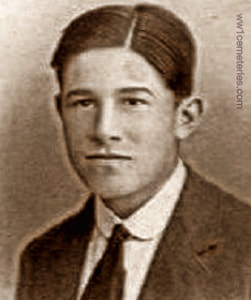
1721 Rifleman
Frederick Claude Butt
5th Bn. London Regiment (London Rifle Brigade)
6th July 1916.
Plot IV. A. 1.
Frederick Claude Butt
5th Bn. London Regiment (London Rifle Brigade)
6th July 1916.
Plot IV. A. 1.
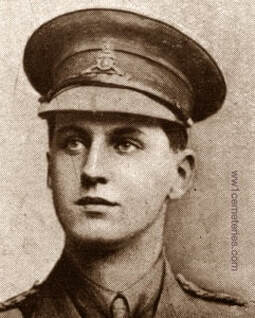
Second Lieutenant
William Humphrey Coghlan
11th Bty. 15th Bde. Royal Field Artillery
26th August 1914, aged 24.
Plot III. B. 4.
William Humphrey Coghlan
11th Bty. 15th Bde. Royal Field Artillery
26th August 1914, aged 24.
Plot III. B. 4.
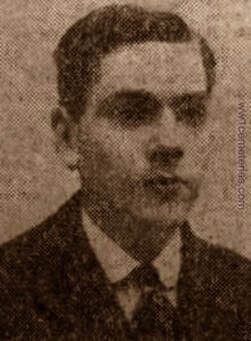
42867 Private
T. W. Collingwood
1st Bn. Lincolnshire Regiment
28th March 1918, aged 19.
Plot V. A. 3.
Born at Great Coates. Lincs. Son of Thomas D. and Hannah Collingwood, of 44, Diana St., Scunthorpe, Lincs.
T. W. Collingwood
1st Bn. Lincolnshire Regiment
28th March 1918, aged 19.
Plot V. A. 3.
Born at Great Coates. Lincs. Son of Thomas D. and Hannah Collingwood, of 44, Diana St., Scunthorpe, Lincs.
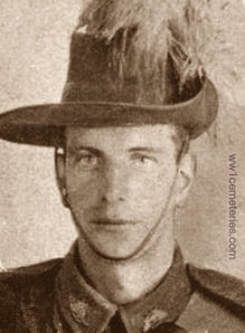
20937 Driver
James Marshall Davidson
12th A.F.A. Bde. Australian Field Artillery
22nd December 1918, aged 23.
Plot V. H. 8.
Son of James and Jessie Davidson, of 90, Bellgrove St., Dennistoun, Glasgow, Scotland.
His headstone bears the inscription; "In Memory Of A Dearly Loved Son And Brother Deeply Mourned."
James Marshall Davidson
12th A.F.A. Bde. Australian Field Artillery
22nd December 1918, aged 23.
Plot V. H. 8.
Son of James and Jessie Davidson, of 90, Bellgrove St., Dennistoun, Glasgow, Scotland.
His headstone bears the inscription; "In Memory Of A Dearly Loved Son And Brother Deeply Mourned."
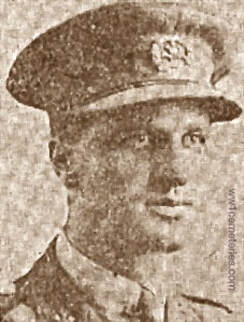
Second Lieutenant
Herbert Jones
5th Bn. South Lancashire Regiment
4th November 1918, aged 26.
Plot II. B. 9.
His headstone bears the inscription; "At Rest."
Herbert Jones
5th Bn. South Lancashire Regiment
4th November 1918, aged 26.
Plot II. B. 9.
His headstone bears the inscription; "At Rest."
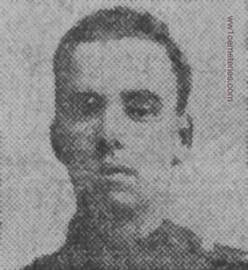
26071 Private
W. J. Lavery
5th Bn. Royal Inniskilling Fusiliers
17th October 1918.
Plot II. E. 5.
Son of Samuel and Margaret Lavery; husband of Mary Harvey (formerly Lavery), of 10, Carnan St., Belfast.
His headstone bears the inscription; "Present With The Lord."
W. J. Lavery
5th Bn. Royal Inniskilling Fusiliers
17th October 1918.
Plot II. E. 5.
Son of Samuel and Margaret Lavery; husband of Mary Harvey (formerly Lavery), of 10, Carnan St., Belfast.
His headstone bears the inscription; "Present With The Lord."
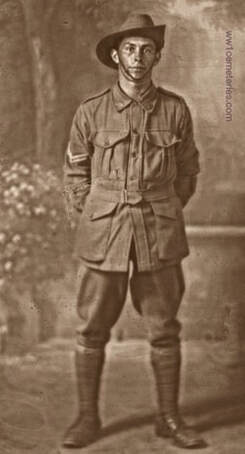
6602 Private
Lindon George Albon Peisley
19th Bn. Australian Infantry, A. I. F.
1st October 1918.
Plot I. B. 152.
Pte Peisley was reported wounded in action and taken prisoner of war of the Germans on 31 August 1918. He was later reported to have died of his wounds whilst in captivity in France on 1 October 1918.
He died at Kriegslazarett No.10, Le Cateau. He was originally taken prisoner on 1st September 1918 at Mont St. Quentin, near Peronne. He was admitted to the hospital with a Gun Shot Wound to the back and broken thigh bone.
Lindon George Albon Peisley
19th Bn. Australian Infantry, A. I. F.
1st October 1918.
Plot I. B. 152.
Pte Peisley was reported wounded in action and taken prisoner of war of the Germans on 31 August 1918. He was later reported to have died of his wounds whilst in captivity in France on 1 October 1918.
He died at Kriegslazarett No.10, Le Cateau. He was originally taken prisoner on 1st September 1918 at Mont St. Quentin, near Peronne. He was admitted to the hospital with a Gun Shot Wound to the back and broken thigh bone.
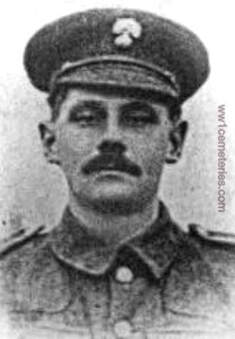
28227 Private
Ernest Silvester
4th Bn. Grenadier Guards
15th December 1917, aged 34.
Plot V. D. 3.
Son of the late Charles and Emily Silvester, of Waltham St. Laurence, Twyford; husband of Annie Elizabeth Silvester, of Hinton Corner, Hurst, Twyford, Berks.
His headstone bears the inscription; "Peace Perfect Peace."
Ernest Silvester
4th Bn. Grenadier Guards
15th December 1917, aged 34.
Plot V. D. 3.
Son of the late Charles and Emily Silvester, of Waltham St. Laurence, Twyford; husband of Annie Elizabeth Silvester, of Hinton Corner, Hurst, Twyford, Berks.
His headstone bears the inscription; "Peace Perfect Peace."
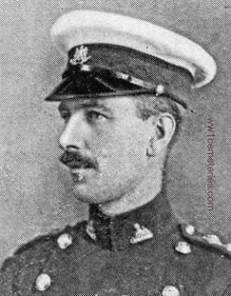
Captain
Charles Fitzgerald Hamilton Trueman
2nd Bn. Manchester Regiment
26th August 1914, aged 37.
Plot III. A. 3.
Son of the late Lt. Col. and Mrs. C. Hamilton Trueman, of Oakwell-in-the-Blean, Canterbury.
His headstone bears the inscription; "R. I. P."
Charles Fitzgerald Hamilton Trueman
2nd Bn. Manchester Regiment
26th August 1914, aged 37.
Plot III. A. 3.
Son of the late Lt. Col. and Mrs. C. Hamilton Trueman, of Oakwell-in-the-Blean, Canterbury.
His headstone bears the inscription; "R. I. P."
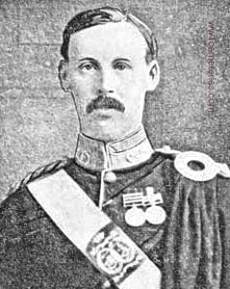
Captain
Charles Corbould Walker
"A" Coy. 2nd Bn. Argyll and Sutherland Highlanders
26th August 1914, aged 39.
Plot III. A. 5.
Son of William Eden and Mary L. Walker; husband of Lucy Jane Walker, of Longdowne, Lower Bourne, Farnham, Surrey. Served in the South African Campaign.
His headstone bears the inscription; "Mens Conscia Recti." (Latin; A Mind Conscious of Integrity.)
Charles Corbould Walker
"A" Coy. 2nd Bn. Argyll and Sutherland Highlanders
26th August 1914, aged 39.
Plot III. A. 5.
Son of William Eden and Mary L. Walker; husband of Lucy Jane Walker, of Longdowne, Lower Bourne, Farnham, Surrey. Served in the South African Campaign.
His headstone bears the inscription; "Mens Conscia Recti." (Latin; A Mind Conscious of Integrity.)

